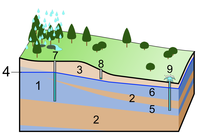
Photo from wikipedia
Introduction Groundwater-flow models are often calibrated using a limited number of observations relative to the unknown inputs required for the model. This is especially true for models that simulate groundwater–surface… Click to show full abstract
Introduction Groundwater-flow models are often calibrated using a limited number of observations relative to the unknown inputs required for the model. This is especially true for models that simulate groundwater–surface water interactions. In this case, subsurface temperature sensors can be an efficient means for collecting long-term data that capture the transient nature of physical processes, such as seepage losses. Continuous and spatially dense network of diverse observation data can be used to improve knowledge of important physical drivers, conceptualize, and calibrate variably saturated groundwater flow models. An example is presented for which the results of such analysis were used to help guide irrigation districts and water management decisions on costly upgrades to conveyance systems to improve water usage, farm productivity, and restoration efforts to improve downstream water quality and ecosystems. High seepage losses from unlined canal systems are common in many basin-scale irrigation systems. These losses result in less water available for irrigation, higher groundwater pumping to supplement reduced surface water deliveries, and less water available for ecosystems. Ongoing investigations of water resources within the Walker River Basin in west-central Nevada provide one example. A broad evaluation of management scenarios in the basin included consideration of water right purchasing to increase inflows, reduce rising salinity levels, and improve the Walker Lake ecosystem. As a part of this study, canal seepage losses were estimated along several reaches using two-dimensional (2D) variably saturated groundwater flow models calibrated against temperature and pressure data (Naranjo and Smith 2016). The results of the study help prioritize future canal conveyance
Journal Title: Ground water
Year Published: 2017
Link to full text (if available)
Share on Social Media: Sign Up to like & get
recommendations!